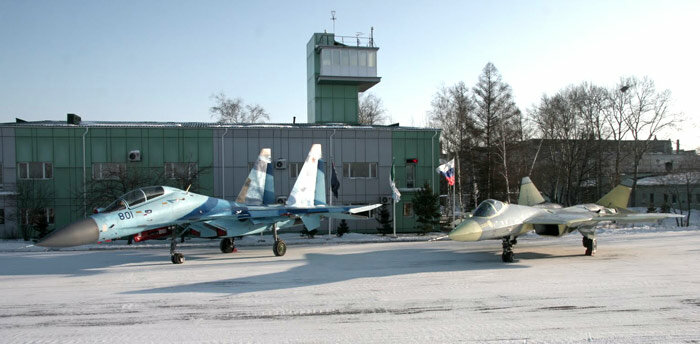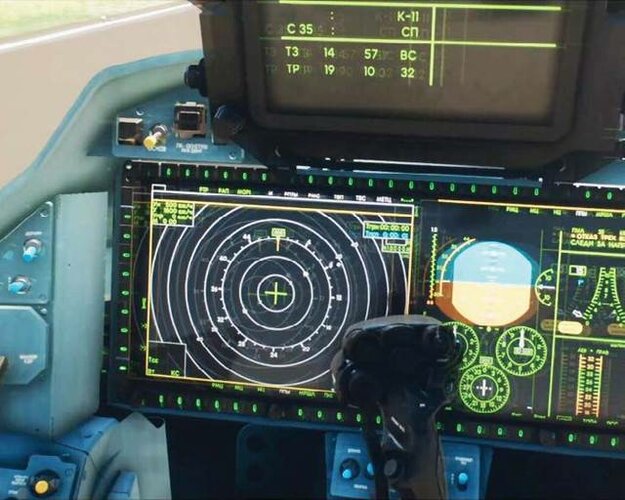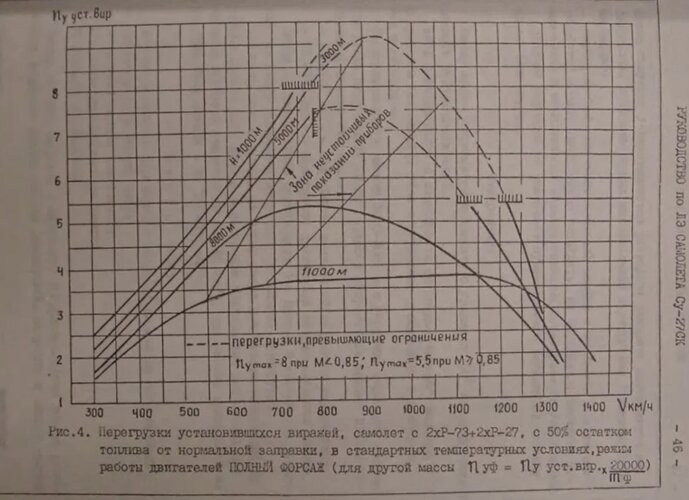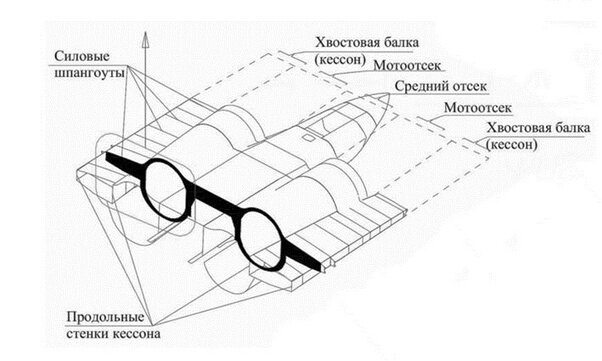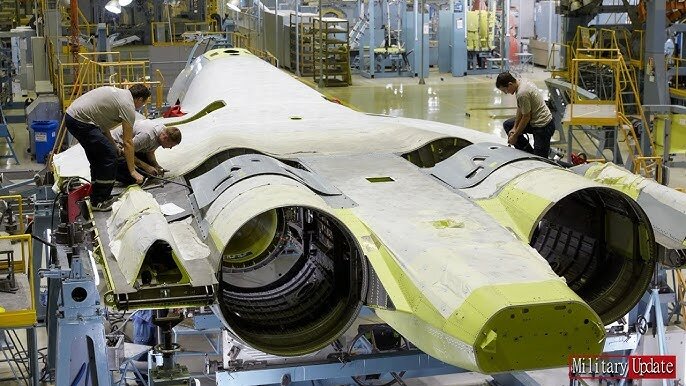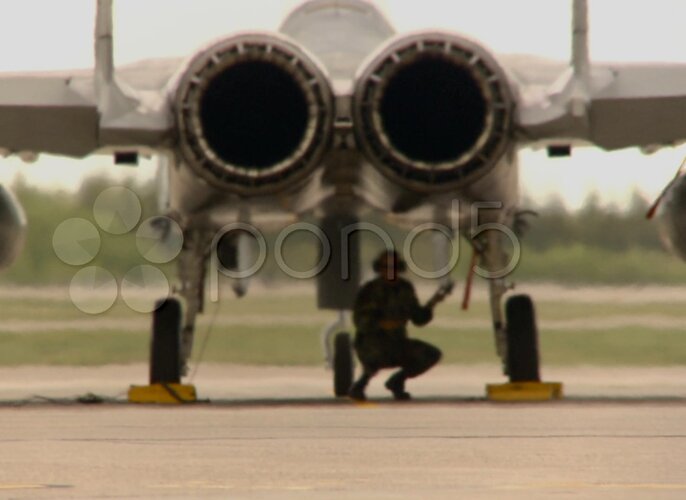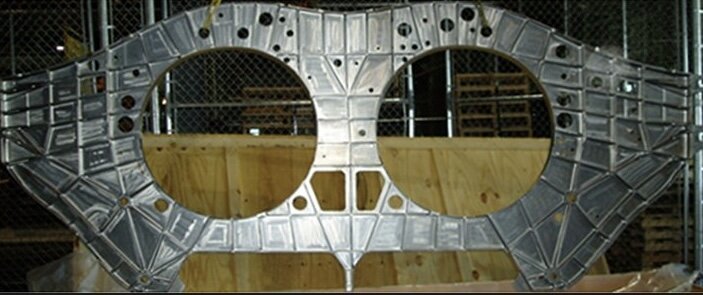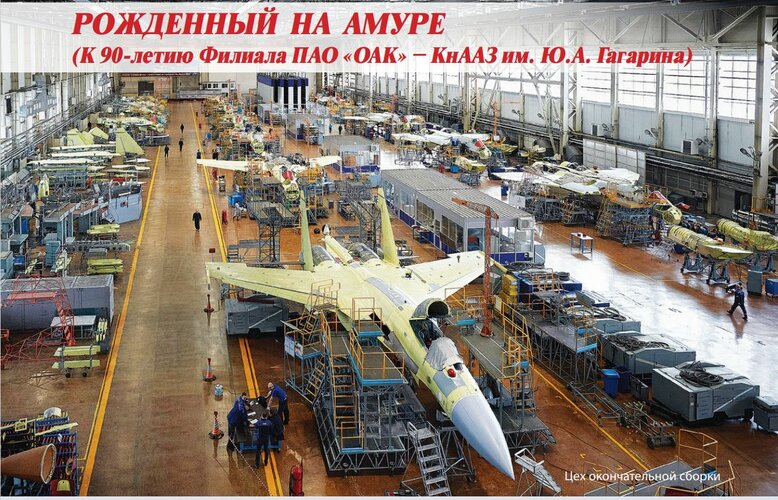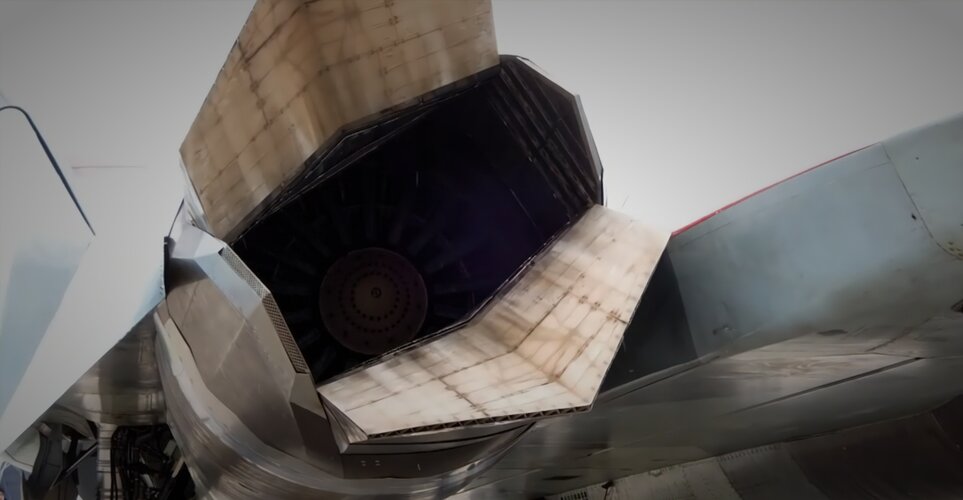Sorry for the late reply, I didn’t have the time for writing!
“перегрузка“ would be equivalent to the US “load factor - G”.
Under number 2. from your chart, it is stated that the maximal exploitation/operational load factor (G limit) is 8G under 21400 kg flight weight.
171000 kg of lift force corresponds to that weight and G load.
People should be careful with these data because as far as I know, that data is taken from the pilots handbook G limit for the Su-27, and there is different set of G limits for combat performance, from supplemental manual. From my understanding, Su-27 in peace time conditions is always limited to 8-8,5G’s.
Here is the chart for similar type of limitations for the F-15:
View attachment 751667
That only shows that your claim that Su-27 is somehow light because it can’t withstand G forces other fighters can under similar conditions is unfounded.
Here is the chart I was talking about:
View attachment 751447
It states, “перегрузка” - load factor for the sustained turns at the weight of 20000 kg (missiles included, 50% of fuel from the normal fuel load etc.)
The full lines represent the G load for the 8G limit, and intersected lines represent the G load when the exploitation 8G limit is exceeded/overridden.
If there was serious danger of destroying the airframe under 9G sustained turn at 20000 kg, there wouldn’t be such option on the EM chart, and the plane would be hard limited to 8G.
Su-57 is basically using cropped delta wing, and here are the basic structural benefits from using such wing:
“The long root chord of the delta wing and minimal area outboard make it structurally efficient. It can be built stronger, stiffer and at the same time lighter than a swept wing of equivalent aspect ratio and lifting capability.
Its long root chord also allows a deeper structure for a given airfoil section. This both enhances its weight-saving characteristic and provides greater internal volume for fuel and other items, without a significant increase in drag. However, on supersonic designs the opportunity is often taken to use a thinner aerofoil instead, in order to actually reduce drag.”
View attachment 751448
Su-57 has significantly shorter wings, and when pressure is applied, much longer and narrower wings of the Su-27 suffer from much greater moment arm/leverage from the force acting upon it, so they need more strengthening for the same load.
And when we talk about lift to drag ratio, I have almost no doubt that Su-57 is superior in this regard. F-22 according to measurements has worse L/D ratio than Su-27 (11,6 vs 10,1 if I remember correctly).
Taking into account the amount of fuel F-22 can carry, it has very poor range (not so efficient engines and not so stellar lift to drag ratio will do that).
Su-57 is highly unstable plane (both in pitch and lateral direction) which provides excellent L/D ratio in subsonic/supersonic area, and that was possible to do with the use of LEVCON’s which can actively control the center of lift.
There was a study where they were comparing standard model with fixed LERX, and the one that had movable frontal part (LEVCON).
For example, the data for the 25 deg. AoA, shows that the model without LEVCON deflection has Cl - 0,726 and Cd - 0,329.
For the same AoA, model with LEVCON deflection has Cl - 0,835 and Cd - 0,364.
We can see significant increase in Cl and just a slight increase in Cd which leads to better lift to drag ratio.
But in practical terms, LEVCON deflection also decreases drag for the similar lift that is generated.
In other words, model with the LEVCON deflection can generate Cl - 0,742 at 20 deg. AoA, which is even greater than what the model without LEVCON deflection can generate at 25 AoA, but at the same time model with LEVCON deflection will have Cd - 0,241, which is significantly lower than the Cd for the model with fixed LEVCON.
That means the plane with LEVCON deflection will have significantly better lift to drag ratio and SEP (specific excess power).
In practical terms you can generate the same or higher amount of lift at lower AoA, but at the expense of less drag which leaves you with power reserve (you need less power to fight lesser amount of drag), and that translates into better sustained turn rates, or you can use more available lift for better instantaneous turn rates.
And that is just one aspect of many advantages LEVCON’s provide.
Here is how that looks in practical terms:
View: https://youtu.be/je3ieoSb6AA?si=09iduyZAhiWHpHXW
Years back Su-57 demonstrated minimum radius turn in just 15 seconds at an air show, so the plane obviously doesn’t have any issues with increased drag in a turn, even if it uses AL-41F-1 engines.
While the Su-57 weapons bays are not “structural”, they don’t have to be because the solution Russian designers applied is very smart and practical.
View attachment 751669
We can see that the Su-35S can hold 4 missiles in the tunnel between air intakes and engines. If you just close that tunnel with doors you are not going to compromise the structural integrity of the plane.
In a sense, that is exactly what the Russians did with the Su-57.
They have applied proven solutions with blended wing-body layout, and they have calculated the optimal structural depth for the fuselage between the engines/intakes for structural rigidity, and they have added weapons bay doors at the point where they find it the most optimal for the weapons needed to be carried inside, while also taking aerodynamic properties into consideration.
Weapons bay doors are also stressed during high G maneuvering, so additional strengthening of the side walls (where they are attached) is needed.
We can see that on the drawing from the T-50 patent:
View attachment 751672
For that reason Su-57 doesn’t need the full depth bulkheads in that region, and the bulkhead between the weapons bays is simply additional strengthening measure.
Now, look at the structural depth of the fuselage of the Su-35S:
View attachment 751674
It is also “thin”, but no one is complaining, Su-35S is a monster of a plane!
As a matter of fact, to me Su-57 looks more robust in that area even taking the weapons bay into consideration:
View attachment 751675
Now, in my opinion the main reason for structural cracks during testing faze is predominantly tied to the materials used (that are not used in Su-35S construction).
Russians wanted to make the Su-57 as light as possible, and the new materials used were simply not adequate. Using different materials, that have somewhat higher specific weight has solved the problem.
The “Sukhoi book” states that the rejected alloy saved 100-120 kg, which is not that significant on the grand scale, and we can’t make educated guess how heavier Su-57 became, but most of the time almost every plane is getting heavier going from the prototype to operational stage.
But all available data suggests that the Su-57 is lighter than F-22, while being bigger plane dimensionally.
Here is the size comparison between F-22 and F-15:
View attachment 751676
Aside from the bigger wing surface, F-22 is about the same as F-15 dimensions vise, but when we compare cross sections of both planes, difference is huge!
View attachment 751677
View attachment 751678
F-22 has huge midsection because it needs to store extremely long and curved air ducts, weapons bays, and considerable amount of fuel inside airframe that has similar layout as the F-15 with closely coupled engines.
View attachment 751679
Basically the whole area behind the cockpit is essentially empty space that is susceptible to bending under high load, and that needs strengthening. Flat belly of the F-22, while not generating lift in the way body of the Su-57 does, is generating lift, and weapons bay doors, and air ducts are also stressed.
This is the bulkhead of the F-22 in the region in front of the engines where weapons bay ends:
View attachment 751680
It is massive, and since the F-35 basically has the same airframe layout as F-22 (just with one engine), here is the bulkhead of the F-35 from the similar region:
View attachment 751681
It is huge!
F-35 is even heavier than the much bigger, two engined, heavy fighter like F-15!
View attachment 751682
Now, when we compare the midsection of the Su-57 and Su-35S, there is absolutely no radical difference between the two (as is the case with the F-22 and F-15):
View attachment 751684View attachment 751685
In essence Su-57 retains all the advantages of the Flanker layout (highly maneuverable, huge range, big weapons capacity etc.) with not so much downside effects.
F-22 layout with close coupled engines and huge curved air intakes is the main limiting factor for the better exploitation of the internal space, and overall performance.
View attachment 751706
So much thinner, but so much better usage of the space. Su-57 is a true air superiority/multirole fighter, and when talking about speed, there is a reason Su-57 is having complex variable air intakes:
While the air intakes are Mach 3 capable, canopy, composites, and RAM will not allow for that speed (2600 km/h is the usual cited top speed), but my guess is that the Russians are aiming at Mach 2 supercruise with AL-51F-1 engines, where this type of intake will come handy.






